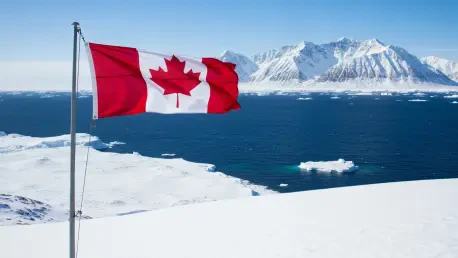Canada is emerging as a determined player on the global stage with a sweeping new focus on the Arctic, a region brimming with untapped potential and escalating strategic importance. Under the stewardship of Prime Minister Mark Carney, the nation is charting an ambitious course to develop its northern territories—Northwest Territories, Yukon, and Nunavut—transforming them into hubs of economic activity and bastions of national defense. This initiative transcends mere resource extraction; it represents a comprehensive effort to safeguard security, affirm sovereignty, and respond to the intensifying interest from global powers such as Russia and China. The Arctic, long perceived as a distant and desolate frontier, has evolved into a critical arena for geopolitical influence and economic opportunity, compelling Canada to act decisively.
At a time when melting polar ice is reshaping the region, both challenges and prospects are coming into sharp focus, highlighting a critical turning point for the Arctic. New shipping lanes and access to vast reserves of minerals, oil, and gas are creating economic opportunities, yet they also heighten security risks as foreign entities turn their attention northward. Canada’s response is a multifaceted strategy that intertwines economic investment with military reinforcement and community development. From launching large-scale infrastructure projects to strengthening alliances with the United States, the country is staking its claim as a proactive force in this evolving landscape. The stakes are immense, with adversaries probing vulnerabilities and allies seeking assurance, making Canada’s moves in the Arctic a clear signal of its commitment to protecting its interests and borders.
Economic Opportunities and Resource Development
Harnessing Critical Minerals for Global Impact
Canada’s Arctic agenda places significant weight on exploiting the region’s abundant reserves of critical minerals, which are indispensable for military technology and global supply chains. Projects like the NICO cobalt-gold-bismuth-copper development in the Northwest Territories stand as flagship examples, drawing substantial funding from both Canadian and U.S. sources. This focus is not merely about boosting the economy; it’s a strategic maneuver to diminish reliance on supply chains dominated by China, aligning closely with North American goals. The minerals extracted from these northern territories are poised to play a pivotal role in manufacturing advanced defense equipment, positioning Canada as a key supplier in a competitive global market. Beyond immediate financial gains, this initiative underscores a broader vision of economic security, where control over essential resources translates into geopolitical leverage amidst rising international tensions.
The drive for resource development also reflects a calculated effort to diversify Canada’s economic base while addressing global demands for sustainable and secure supply chains. By prioritizing the Arctic’s mineral wealth, the government aims to attract international partnerships and investments, fostering a network of economic ties that bolster its standing. This approach, however, must navigate the region’s harsh environmental conditions and logistical hurdles, which can inflate costs and delay timelines. Despite these obstacles, the commitment to projects like NICO signals a long-term perspective, where economic resilience is intertwined with strategic autonomy. The potential to reshape global trade dynamics through Arctic resources places Canada at the forefront of a critical industry, with implications that extend far beyond its borders.
Infrastructure as an Economic Catalyst
Beyond minerals, Canada is investing heavily in infrastructure to unlock the Arctic’s economic potential, viewing it as a gateway to broader prosperity. Plans for expansive networks of roads, ports, and energy facilities are taking shape, designed to facilitate resource extraction and connect remote northern areas to southern markets. These developments promise to transform isolated regions into active economic zones, creating jobs and opportunities for local businesses. The government’s push for such projects is framed as a dual-purpose strategy—while they support industrial growth, they also lay the groundwork for enhanced security measures. This integrated approach ensures that economic gains are not pursued in isolation but are part of a larger framework aimed at strengthening national interests in a contested region.
The economic ripple effects of these infrastructure investments are anticipated to be substantial, particularly for the Arctic’s sparse population, which stands to gain significantly from enhanced connectivity. By improving access to remote territories, the government hopes to stimulate trade and attract private sector involvement, further amplifying growth. However, the scale of these projects brings inherent challenges, including environmental concerns and the need for sustainable planning to protect fragile ecosystems. Balancing economic ambitions with ecological responsibility remains a critical task, as does ensuring that benefits trickle down to local communities rather than being siphoned off by external entities. Nevertheless, the momentum behind these initiatives suggests a transformative potential, positioning the Arctic as a vital component of Canada’s economic future.
Security and Military Enhancements
Strengthening Defense Capabilities
A robust military presence forms a core pillar of Canada’s Arctic strategy, reflecting the urgent need to protect national interests in an increasingly contested region. The government has set ambitious targets to align with NATO’s spending goals by 2035, channeling significant resources into modernizing critical defense systems like NORAD. Upgrades to over-the-horizon radar technology and discussions around a continent-wide missile defense shield highlight a proactive stance on security. Defense Minister David McGuinty’s active engagement with U.S. officials underscores a renewed dedication to collaborative defense efforts, marking a departure from earlier reluctance to participate in similar missile defense programs. This shift is driven by the recognition that the Arctic’s strategic value demands a fortified military posture to deter potential threats.
The focus on defense extends beyond technology to include the expansion of military infrastructure across the northern territories, a critical step in strengthening national security. New bases, training facilities, and logistical hubs are under consideration, aimed at ensuring rapid response capabilities in a region where geography poses unique challenges. These developments are not just about projecting power; they also serve as a tangible assertion of sovereignty, signaling to international actors that Canada is prepared to defend its claims. The harsh Arctic environment, however, complicates such endeavors, with extreme weather and limited accessibility testing the limits of military planning. Despite these hurdles, the commitment to enhancing defense capabilities reflects a broader understanding that security in the Arctic is non-negotiable, forming the bedrock of Canada’s strategic ambitions.
Countering Geopolitical Threats
The Arctic’s evolving landscape, spurred by melting ice, has drawn the attention of global powers like Russia and China, prompting Canada to intensify its security measures to safeguard its interests. New shipping routes and resource access points have heightened the region’s geopolitical significance, making it a potential flashpoint for conflict. Canada’s military strategy is thus geared toward countering incursions and asserting control over its northern borders, with increased patrols and surveillance operations becoming routine. This vigilance is complemented by diplomatic efforts to reinforce international norms and agreements that govern Arctic activities, ensuring that Canada’s interests are protected within a framework of global cooperation. The stakes are high, as any misstep could embolden adversaries and undermine regional stability.
Collaboration with allies plays a crucial role in addressing these geopolitical challenges, with joint exercises and intelligence-sharing forming key components of Canada’s approach. The shared concerns over foreign influence have led to a tightening of strategic partnerships, particularly with the United States, to create a unified front against external pressures. This cooperative stance extends to monitoring maritime activities in newly accessible waters, where the risk of unauthorized presence looms large. While military buildup is a priority, there is also an emphasis on balancing deterrence with dialogue, avoiding escalation in a region already fraught with tension. The complexity of countering geopolitical threats in the Arctic underscores the need for a nuanced strategy that combines strength with strategic foresight.
Sovereignty Through Presence
Establishing a Living Claim
Sovereignty in the Arctic, as emphasized by Northwest Territories Premier Simpson, hinges on more than military might—it rests on the presence of thriving communities. This perspective drives Canada’s push to establish a robust civilian footprint through investments in housing, schools, and essential services that make life viable in the harsh northern climate. The idea is straightforward yet powerful: people living and prospering in the Arctic serve as a living testament to Canada’s claim over the region. This approach counters the narrative of the Arctic as an unclaimed expanse, reinforcing national ownership through everyday human activity. It’s a strategy that blends practical governance with symbolic assertion, aiming to create a sustainable presence that resonates on both domestic and international stages.
Implementing this vision requires overcoming significant logistical barriers, from building infrastructure in extreme conditions to ensuring economic opportunities that retain residents, a challenge that demands innovative solutions. The government’s commitment to dual-use facilities—structures that support both civilian needs and military operations—demonstrates an innovative way to maximize resources. Projects like highways and ports are designed with this duality in mind, facilitating daily life while enabling defense readiness. Yet, the challenge of attracting and sustaining populations in such remote areas persists, with harsh winters and isolation posing constant hurdles. Despite these difficulties, the focus on a living claim offers a unique dimension to Canada’s Arctic strategy, prioritizing human presence as a cornerstone of sovereignty.
Infrastructure for Dual Purposes
Canada’s emphasis on “hard infrastructure” in the Arctic is a strategic move to bolster sovereignty while addressing practical needs, with ports, roads, and military installations being planned not just for defense but also to support civilian life. This creates a seamless integration of security and community development. These projects, championed by leaders like Premier Simpson, aim to transform the region into a connected and functional space where both residents and military personnel can operate effectively. The dual-purpose nature of this infrastructure ensures that investments yield multiple benefits, from enhancing logistical capabilities for defense to improving access to resources and services for local populations. This approach marks a thoughtful balance between immediate security imperatives and long-term societal goals.
The scale of these infrastructure endeavors, however, brings inherent complexities, particularly in a region defined by its vastness and environmental challenges, which require careful consideration and strategic planning to overcome. Construction in the Arctic demands specialized techniques and materials to withstand extreme cold, often driving up costs and extending timelines. Additionally, there is a pressing need to engage local communities in the planning process to ensure that projects align with their needs and cultural values. The proposed networks of connectivity, while ambitious, hold the promise of reshaping the Arctic’s landscape, making it a more integral part of Canada’s national fabric. By embedding sovereignty into the very infrastructure of the region, Canada is crafting a tangible and enduring claim that speaks to both strength and stewardship.
Collaboration with the United States
Building a Unified North American Front
Canada’s Arctic strategy is deeply intertwined with its partnership with the United States, a collaboration rooted in shared concerns over foreign influence in the region. As melting ice opens new maritime routes and resource opportunities, both nations recognize the urgency of securing their northern flanks against incursions by powers like Russia and China. Joint initiatives, including critical minerals agreements and defense projects, amplify Canada’s capabilities while reinforcing a collective North American stance. Under President Donald Trump’s administration, this alignment has gained momentum, with ongoing discussions ensuring that strategic priorities remain synchronized. This partnership serves as a force multiplier, enabling Canada to project greater influence in the Arctic through combined resources and expertise.
The collaboration extends to operational levels, with joint military exercises and shared intelligence forming critical components of Arctic security, demonstrating a strong commitment to mutual defense. NORAD’s modernization, a flagship project of this alliance, exemplifies how integrated efforts can enhance defense readiness across the continent. While the benefits of this partnership are clear, navigating differences in policy and approach remains a subtle challenge, requiring constant dialogue to maintain cohesion. The mutual goal of reducing dependence on adversarial supply chains further cements this bond, as both countries prioritize self-reliance in critical sectors. Through this unified front, Canada and the U.S. are shaping a robust framework to address the Arctic’s geopolitical complexities, ensuring their interests are safeguarded in a rapidly changing environment.
Strategic Defense and Resource Pacts
A key facet of Canada-U.S. collaboration in the Arctic centers on strategic defense and resource pacts that address both security and economic imperatives, highlighting the depth of their partnership. Discussions around a continent-wide missile defense shield, often referred to as the “Golden Dome,” underscore the extent of military cooperation, with Canada playing an active role in shaping this initiative. Simultaneously, agreements on critical minerals aim to secure supply chains vital for defense technologies, reducing vulnerabilities to external disruptions. These pacts are not merely transactional; they represent a shared vision for North American resilience, where strategic resources and military strength are intertwined to counter global threats. The alignment of interests in these areas strengthens Canada’s position within the Arctic’s competitive landscape.
Beyond immediate security concerns, these pacts also lay the groundwork for long-term economic stability by fostering innovation and investment in resource-rich northern territories. Joint funding for projects like the NICO initiative in the Northwest Territories underscores a commitment to mutual benefit, ensuring that both nations gain from the Arctic’s wealth. Challenges persist, including aligning regulatory frameworks and managing environmental impacts, which require careful coordination to avoid friction. Nevertheless, the strategic depth of these agreements provides a solid foundation for addressing the multifaceted challenges of the region. By pooling resources and expertise, Canada and the U.S. are crafting a resilient partnership that extends beyond borders, shaping the Arctic’s future with a unified purpose.
Community Focus and Nation-Building
Uplifting Arctic Populations
Amidst the high-stakes geopolitical maneuvers, Canada remains committed to ensuring that its Arctic strategy delivers tangible benefits to local communities, especially in a region with a population of roughly 42,000 spread across an expanse comparable to California and Texas combined. The region’s residents face unique challenges, from isolation to limited access to services. Prime Minister Carney’s nation-building policy prioritizes projects that enhance economic resilience while tackling practical issues like housing shortages and climate vulnerabilities. Investments in essential infrastructure aim to improve quality of life, ensuring that the benefits of Arctic development are not confined to distant boardrooms but are felt by those who call the north home. This focus on community improvement is a critical piece of the sovereignty puzzle, grounding Canada’s claims in the lived experiences of its people.
Engaging local populations in the development process is essential to the success of these initiatives, as their input helps tailor projects to real needs rather than imposed priorities. Programs designed to create jobs and foster skills training are gaining traction, aiming to empower residents to participate actively in the region’s economic transformation. Yet, the vast distances and harsh conditions of the Arctic pose persistent barriers to equitable development, requiring innovative solutions to bridge gaps in access and opportunity. The government’s emphasis on sustainable growth seeks to address these disparities, ensuring that nation-building efforts leave a lasting, positive impact. By centering community well-being, Canada is weaving a narrative of sovereignty that resonates with both national pride and local relevance.
Connecting Through the Arctic Corridor
The proposed “Arctic Economic and Security Corridor” stands as a flagship initiative within Canada’s nation-building agenda, embodying the dual goals of connectivity and security. This ambitious network of roads and ports is designed to link isolated Arctic communities, spurring economic activity by facilitating trade and resource transport. At the same time, it serves strategic military purposes, enabling faster deployment and logistical support in a region where mobility is often constrained. The corridor represents a visionary approach to integrating the Arctic into Canada’s broader national framework, transforming remote territories into vital nodes of activity. Its potential to reshape regional dynamics is immense, promising to bring both prosperity and protection to an area long defined by its inaccessibility.
Implementing the Arctic Corridor, however, demands meticulous planning to address environmental and cultural sensitivities, ensuring that development does not come at the expense of the region’s unique heritage or ecosystems. Community consultation is paramount, as local knowledge can guide the project’s design to minimize disruption while maximizing benefits. The financial and logistical challenges of building in such an unforgiving environment are significant, requiring sustained investment and international cooperation to see the vision through. Despite these hurdles, the corridor’s promise of connecting people and resources offers a transformative pathway for the Arctic, aligning with Canada’s broader goals of economic growth and strategic presence. This initiative encapsulates the delicate balance between progress and preservation that defines the nation’s northern ambitions.
Reflecting on a Strategic Milestone
Looking back, Canada’s concerted push into the Arctic marked a defining chapter in its national journey, driven by the leadership of Prime Minister Mark Carney and bolstered by local advocates like Premier Simpson. The comprehensive approach, weaving together economic ventures, military fortifications, and community enhancements, established a robust foundation for asserting sovereignty in a region of growing global interest. Collaborative efforts with the United States amplified these achievements, creating a formidable North American stance against external pressures. As challenges like harsh climates and logistical complexities were navigated, the focus on integrating local benefits with strategic goals emerged as a hallmark of this era, ensuring that the Arctic became more than just a frontier—it became a vital part of Canada’s identity. Moving forward, sustained investment and adaptive policies will be crucial to build on this legacy, addressing emerging risks while seizing new opportunities in a dynamic northern landscape.









